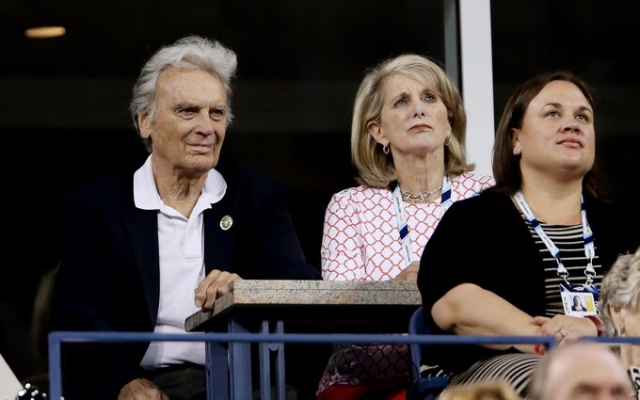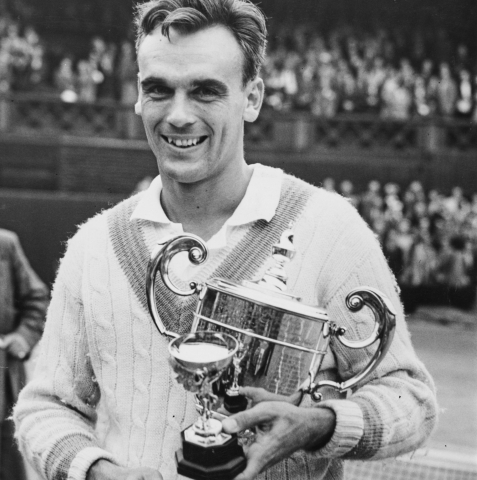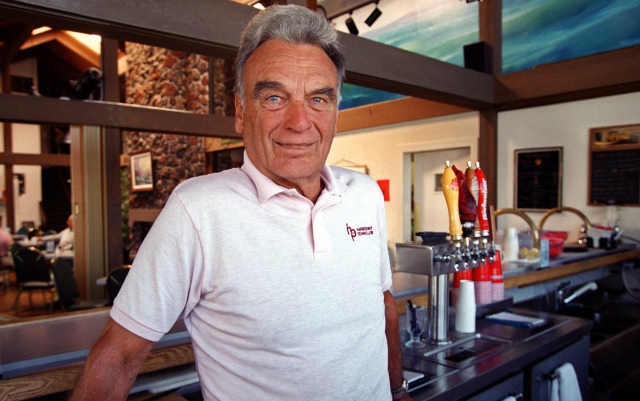 Vic Seixas (left), pictured at the 2014 US Open, turns 100 in August. Credit: Getty Images/Matthew Stockman
Vic Seixas (left), pictured at the 2014 US Open, turns 100 in August. Credit: Getty Images/Matthew Stockman
«Great» is the first word former BBC commentator Christine Truman comes up with when I ask her about Vic Seixas, a stockbroker, bartender, wartime aviator and oldest survivor in living Grand Slam champions at the age of 99 years and 302 days.
“My best memory of Vic is going to MGM Studios together in 1958 when I played a tournament in Los Angeles,” Truman said. “They were making a movie called Some Come Running and we met the stars: Frank Sinatra, Dean Martin and Shirley MacLaine. I remember thinking that Vic looks so much like a matinee idol that he could be in the movie himself.”
 Seixas defeated Kurt Nielsen to win the Wimbledon final in 1953. Photo: Getty Images/William Vanderson
Seixas defeated Kurt Nielsen to win the Wimbledon final in 1953. Photo: Getty Images/William Vanderson
It was five years after Seixas (pronounced Sai-shous) defeated Dane Kurt Nielsen to win the Wimbledon Trophy. His reward was a £25 Lilywhites voucher which he spent on a new sweater.
Today, Seixas lives in Harbor Point, near San Francisco, with her daughter, Tori. He has received several invitations to attend major tournaments, especially since this summer marks the 70th anniversary of his great triumph at Wimbledon. But when I called him last month, he admitted that he didn't feel much desire to travel.
“I recently returned to Wimbledon with Tory,” he explained, “but I was confined to a wheelchair for quite some time. In August I will be 100 years old and my eyesight is not so good anymore.
“I have a Tennis Channel here, but I don't follow it much now that Roger Federer has retired. He was a great player and I enjoyed watching him. I no longer enjoy watching. Mostly they play from the back line, but I liked to go to the net. Roger could do both. He could do anything.»
 Seixas enjoyed looking at Roger Federer, but now that the great Swiss is retired, he doesn't follow the game that much. Photo: Getty Images/Jed Leicester.
Seixas enjoyed looking at Roger Federer, but now that the great Swiss is retired, he doesn't follow the game that much. Photo: Getty Images/Jed Leicester.
Seixas is still witty and speaks warmly of his era of tennis, especially of the many Australians who dominated the sport in the 1940s and 50s: Lew Hoade, Ken Rosewall, Frank Sedgman.
I could hear him smile as he moved on to his Grand Slam tally. «Here's something you might be interested in for your article,» Seixas said. “There are 12 tournaments in the majors, counting singles, men's and mixed doubles. I ticked 11 — because I've never competed in mixed doubles at the Australian Open — and won titles in eight of them. The other day I thought, «I wonder if anyone won more?»
But his life story includes much more than fluffy yellow balls — or, in fact, fluffy white balls, as they were when he won his 15 major titles [two singles, five in doubles and eight in mixed doubles].
Even before he started playing elite tennis, Seixas was posted to Papua New Guinea as an 18-year-old Army Air Corps recruit. As a flight instructor coordinating flights against Japanese targets, he learned to fly 14 different aircraft, from the P-51 Mustang [the closest US equivalent of the Spitfire] to the B-24 Liberator Bomber [an improved version of the Lancaster].
But while Seixas might have enthusiastically jumped into the draft, he shied away from the family business—piping, heating, and roofing—when he returned home in 1946. Instead, he married the charming Dolly and went to amateur tennis. As he told tennis historian Allen Hornblum, “I had a good life without making any money. I had our travel expenses paid for, accommodation at tournaments was usually pretty good, and Dolly, like me, was excited to see the world.» Truman recalls that Seixas' game was less beautiful than his personality, and Hornblum describes his groundstrokes as «average at best». But once he got to the net, he was a phenomenal athlete and at 6ft 2in he was extremely difficult to pass. Hence his inevitable punning nickname: Annoying.
As his career progressed, Seixas remained competitive well into his 40s thanks to a brutal fitness regimen. He was 43 years old when he defeated 19-year-old future Wimbledon champion Stan Smith [1972] in a five-set match at the US Championship. By that time, he was already combining his tennis with stock brokerage. A 17-year stint with industry giant Goldman Sachs should have helped offset at least some of the prize money [probably around £30-40m on today's payout scale] that he was denied in amateur competition. Yet money will still be a problem for him in his later life. The «magnificence» that Truman speaks of could be a problem here. In the 1970s, Seixas divorced Dolly to marry a coach he had hired while running a tennis business at the Greenbrier resort in West Virginia. But this second marriage also failed.
 In the 1970s, one of several career changes led Seixas to become a bartender. Photo: AP/Georgy Nikitin
In the 1970s, one of several career changes led Seixas to become a bartender. Photo: AP/Georgy Nikitin
Necessity led to yet another career change. Seixas became a bartender in his 70s. According to eminent author Reeves Wiedemann, he «moved to the Bay Area in 1989, after his second divorce, and took a job as 'morning bartender' at a coffee shop, serving screwdrivers and martinis to everyone who left the night. shift at 6 am. Most of the regulars didn't know about his past, although one of his regulars blabbed to a group of policemen who came one summer morning when Seixas was showing Wimbledon on television in a café.
When I asked him about this job as a bartender, Seixas smiled slightly sadly. “Everyone seems to like to know that. I don't know why it seems so unusual for someone to work behind a bar. I liked to have a drink from time to time, I liked spending time there. I think it's a good topic to talk about.»
Seixas seems to be comfortable at the Harbor Club, where some of his trophies are kept in a box in the clubhouse. He was 95 when he received a surprise bonus from the same Stan Smith he once defeated in New York. Those interested in running shoes should know that Smith made an absolute masterpiece with the Adidas running shoes that bear his name, and he had the foresight to sign Seixas to a $2,000 a month deal. As the new Adidas 'ambassador', who is under 10, put it: «I asked them, 'How long is this?' They replied, «Until you die or we go bankrupt.»
Truman ran into Seixas during his last visit to Wimbledon in the late 2010s [in which case exact dates are difficult to establish]. “It was great,” she says now. “In the old days he was so charming, always glad to see you. And even in his 90s, he seemed just as happy to see me as he was when we were both players.”





















































Свежие комментарии